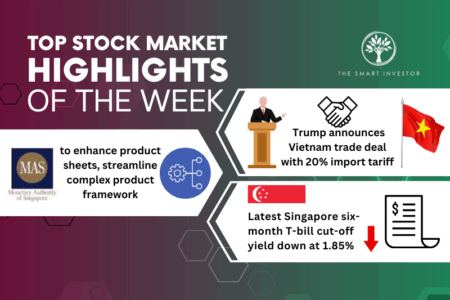Welcome to this week’s edition of top stock market highlights.
US interest rates
The latest meeting held by the US Federal Reserve (“Fed”) saw interest rates held steady at their highest in 23 years, in a range of 5.25% to 5.5%.
However, the US central bank hinted that it is now closer to easing its monetary policy as there was “further progress” in its fight against inflation.
The members of the Fed are gathering more data to gain the confidence to reduce interest rates, even as inflation continues to cool and the job market slows down.
Fed chairman Jerome Powell commented that a rate cut could be on the table in September if the stars align for inflation and the economy.
However, he reiterated that if inflation proved stickier than expected, then rates could still be maintained at current levels.
Three straight months of better inflation data have bolstered the case for an eventual rate cut before the end of this year.
However, investors may wish to hold their breath for now as incoming data for August and September will still be scrutinised closely to asses if a rate cut is appropriate.
United Overseas Bank Ltd (SGX: U11)
United Overseas Bank, or UOB, reported its second quarter (2Q 2024) and first half of 2024 (1H 2024) earnings this week.
Net interest income for 1H 2024 dipped by 2% year on year to S$4.8 billion as the bank’s net interest margin eased to 2.05% for 2Q 2024 compared with 2.12% in 2Q 2023.
Despite the decline, fee income did well, climbing 11% year on year to S$1.2 billion, buoyed by a pick-up in loans and wealth.
Loans also grew 3% year on year to S$327.6 billion, helping to offset the lower net interest margin.
UOB’s operating expenses inched up 1% year on year, resulting in operating profit sliding by 3% year on year to S$4.1 billion.
Net profit came in at S$2.9 billion, in line with 1H 2023’s net profit, after accounting for S$143 million of expenses relating to the integration of its Citigroup (NYSE: C) acquisition.
UOB upped its interim dividend by S$0.03 to S$0.88, representing a payout ratio of 51%.
The bank painted an optimistic outlook for 2024 and is expecting low single-digit loan growth along with double-digit fee income growth.
Keppel Ltd (SGX: BN4)
Keppel was the next to release its 1H 2024 results.
The asset manager saw its revenue dip by 13% year on year to S$3.2 billion, with the main culprits being a 10% year-on-year decline in revenue for its Infrastructure division and a sharp 44% year-on-year plunge in revenue for its Real Estate division.
Operating profit for the group fell by 12% year on year to S$506 million.
However, core net profit (excluding one-offs and discontinued operations) rose 7% year on year to S$513 million.
The blue-chip group declared an interim dividend of S$0.15, unchanged from a year ago.
There were several noteworthy bright spots worth highlighting.
Keppel’s funds under management climbed 55% from S$55 billion at the end of 2023 to S$85 billion in 1H 2024, with S$25 billion of contribution coming from the acquisition of Aermont Capital.
Asset management fees also grew in tandem, surging by 75% year on year from S$116 million in 1H 2023 to S$203 million in 1H 2024.
Meanwhile, Keppel has secured long-term contracts worth S$5.2 billion at end-June 2024, up more than 20% from the S$4.3 billion secured at the end of last year.
These contracts will be progressively recognised over the next 10 to 15 years.
Another positive development is the increase in the group’s recurring revenue, which went up 14% year on year to S$388 million and comprises 76% of 1H 2024’s net profit.
Singapore Airlines Limited (SGX: C6L)
Singapore Airlines Limited just announced its business update for the first quarter of fiscal 2025 (1Q FY2025) ending 30 June 2024.
It was a mixed set of earnings for Singapore’s flagship carrier.
Revenue for 1Q FY2025 edged up 5.3% year on year to S$4.7 billion.
Operating and net profit, however, fell by 37.7% and 38.4%, respectively, to S$470 million and S$452 million.
The weak performance was due to lower yields and a rise in fuel costs that ate into profits.
Passenger traffic rose 9.7% year on year while capacity increased by 12.2% year on year, resulting in the passenger load factor declining by two percentage points to 86.9%.
For cargo, the load factor increased by 5.9 percentage points to 57.7% but this was offset by lower cargo yields that declined by 19.1% year on year because of larger bellyhold capacity.
Although demand for air travel is projected to stay healthy in the upcoming months, management did warn of several headwinds for the business.
The airline industry faces increased competition as more players ramp up their operations while supply chain constraints and inflation will continue to push up operating costs.
Ready to discover the next $100 billion stock? Our newest FREE report dives deep into five popular SGX companies that many say are the next big thing. Read our team’s findings to guide your investment strategy. Click the link here to download now.
Follow us on Facebook and Telegram for the latest investing news and analyses!
Disclosure: Royston Yang does not own shares in any of the companies mentioned.





